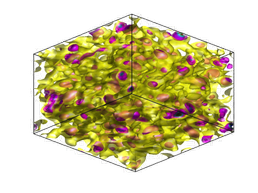Towards Exascale computing in particle physics
- Research Team
- James Harrison
- Investigators
- Andreas Juttner, Jonathan Flynn
Quarks are the fundamental particles that make up most of ordinary matter. They are bound together by the strong nuclear force, mediated by the exchange of gluons as described by Quantum Chromo Dynamics (QCD).
Quarks and gluons are not detected directly in experiments because of confinement; instead we see complicated bound states. By using simulations we are able to relate the bound state properties to those of the underlying quarks. The calculation is performed by constructing a discrete four dimensional space-time grid (the lattice) and then solving the QCD equations of motion on state-of-the-art high performance computers. New physics beyond the current Standard Model (SM) will be discovered through discrepancies between its predictions and experimental measurements such as those currently carried out at LHCb at CERN and at future B factories. LHCb has recently started taking data for processes that are particularly sensitive to new physics.
To interpret the experimental data one needs theory predictions that can only be provided by lattice QCD. In this project new field theoretical methods and massively parallel computational algorithms will be developed and employed on new computational architectures (Intel Xeon Phi) and existing high performance computers which are amongst the fastest available for research. The aim is to complement European investment in experimental facilities by providing robust predictions from theory that are needed to interpret the experimental data.
Categories
Physical Systems and Engineering simulation: QCD
Algorithms and computational methods: Lattice Field Theory
Computational platforms: HPCx, Iridis, Linux, Xeon Phi
Transdisciplinary tags: NGCM, Scientific Computing
